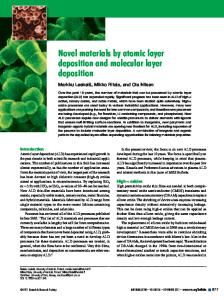Atomic Layer Deposition of Silica and Group IV Metal Oxides Nanolaminates
- PDF / 80,980 Bytes
- 5 Pages / 612 x 792 pts (letter) Page_size
- 46 Downloads / 309 Views
E6.24.1
Atomic Layer Deposition of Silica and Group IV Metal Oxides Nanolaminates Lijuan Zhonga, Fang Chenb, Stephen A. Campbellb and Wayne L. Gladfeltera a Department of Chemistry, bDepartment of Electrical and Computer Engineering, University of Minnesota, Minneapolis, MN 55455, U.S.A. ABSTRACT With alternating exposure of Si (100) substrates to tri (t-butoxy) silanol and anhydrous zirconium nitrate, mixed films of zirconia and silica were deposited at 162°C. The films were atomically smooth and their thickness was uniform across the entire substrate. The maximum growth rate of 12 Å/cycle implies deposition of more than one monolayer per cycle. A singular reflection in the low angle X-ray scattering pattern indicates an ordered bi-layer structure. Similar nanolaminate structures were also formed using anhydrous nitrates of hafnium and tin. INTRODUCTION The search for a high dielectric constant (κ) material to replace silicon dioxide as the gate dielectric in field effect transistors has focused on combinations of metal oxides that produce amorphous films. Mixed ZrO2/SiO2 films, one example under investigation [1-3], have been deposited by sputtering [3], plasma enhanced CVD [4] and atomic layer deposition (ALD) [5-9]. The ALD of ZrO2/SiO2 has been accomplished using individual silicon, zirconium and oxygen source materials [8] and by a two-precursor approach in which one of the precursors also acted as the oxygen source [5-7, 9]. Anhydrous metal nitrates, as carbon-, hydrogen- and halogen-free single-source precursors, have been used in CVD [10, 11] as well as ALD processes [9, 12]. In this article, we report the deposition of alternating layers of silica and zirconia by tri (t-butoxy) silanol [13] and anhydrous zirconium nitrate and detail the film microstructure as a function of deposition conditions. X-ray scattering clearly demonstrates the existence of a layered, nanolaminate structure. The same growth strategy was used to create nanolaminate structures of SiO2 with hafnia and tin oxide. EXPERIMENTAL DETAILS Tri(t-butoxy) silanol((tBuO)3SiOH) (99.9%) was purchased from Aldrich Company and used as received. Anhydrous metal nitrates of zirconium, hafnium and tin (Zr(NO3)4, Hf(NO3)4 and Sn(NO3)4) were synthesized via the reaction of correspondent metal chloride and N2O5 using a modification of literature procedures [14, 15]. The films were grown on p-Si (100) single crystal substrates (approximately 1¨ square) in a cold-wall, low-pressure CVD reactor described elsewhere [10]. High-purity N2 was used as both carrier and purge gas. In all depositions, the flow rate of carrier and purge gas as measured by mass flow controller was 25 sccm and 50-75 sccm, respectively. The (tBuO)3SiOH was set to 35ºC when depositing with Zr(NO3)4 while kept at room temperature when depositing with Hf(NO3)4 and Sn(NO3)4 . The Zr(NO3)4 and Hf(NO3)4 precursor vessels were heated to 65ºC and 70 ºC, respectively. The temperature of Sn(NO3)4 was kept at room temperature. The deposition temperature was 162±2ºC and the overall reactor press
Data Loading...










